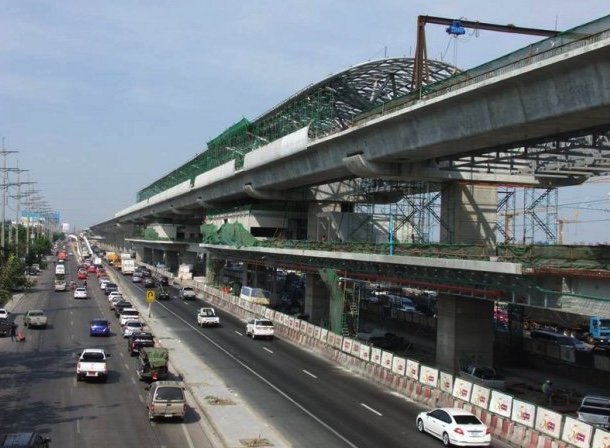There is no doubt that, if left to stand for the next thousand years, the yet-unborn generations of Thais would be debating the possible purpose of hundreds of concrete pillars that lined the stretch of railroad in northern Bangkok.
For the moment, though, the towering concrete slabs – appropriately nicknamed by many as ′Bangkok Stonehenge′ – have been useful to a local vendor. The ′Stonehenge′ has been providing the shades that help shield her stall from the sun of Bangkok ever since she started her career a decade ago, she said.
A quick disclaimer, though – she was being sarcastic.
“Actually, I′m really bored of it,” said the vendor, Ms. Somsri Boonthet, “They should have got rid of these things long ago because they are so useless”.
The Stonehenge is, in fact, the remnants of what would have been the ambitious Bangkok Elevated Road and Train System (BERTS), also known to the Thais as the Hopewell Project.
Proposed during the administration of Prime Minister Chatichai Chunhawan during the economic boom in 1990, the project was intended to improve the services of State Railway of Thailand (SRT). The plan would have seen multiple elevated railways linking Bangkok with its outer provinces.
However, the ′mega project′ was repeatedly postponed by a series of political instability and massive corruption. On 20 January 1998, Minister of Transport at the time, Mr. Suthep Thaugsuban (who is now leading a protest against the current government), eventually called it quit.
The cancellation came at an enormous price for Thailand. The government was forced to pay Hong Kong-based Hopewell Holdings owned by the billionaire Gordon Wu an amount of 11.8 billion baht for unfair agreement cancellation.
The 532 concrete pillars have since been left standing. To many Thais, the ′Bangkok Stonehenge′ serve as a costly monument to the incompetence and corruptions that are often associated with so many governments that have ruled the country.
In the following two decades, the said monument also became shelters for birds, while graffiti artists showed off their skills on some of the pillars.
But as the government is pushing for the construction of Red-Line Sky Train services, which runs from Bang Sue to Rangsit, the Bangkok Stonehenge is finally being dismantled. The demolition was agreed in June 2013 when the SRT instructed Italian-Thai Development firm to destroy the rows of these concrete skeletons and pave way for future development.
The dismantling is planned to be completed no later than March 2014, and – according to interviews conducted by Matichon correspondents – the locals are not shedding any tears.
Ms. Somsri, the vendor, is one of them. “The demolition has not affected me at all, and it will definitely make the scenery around here look a lot better,” said Ms. Somsri, whose stall is located just opposite Wat Samien Naree Temple.
She added with a smile, “Once these pillars are gone, maybe the area will experience further improvements that promote my business.”
The demolition is proceeding slowly. The workers have to stop for the trains that run on the tracks just beneath the concrete slabs, and the crowded daily market in the evening near Wat Samien Naree Temple forced the engineers to work more slowly.
But Mr. Surasak Meesombat, a taxi driver, said he wished the process would go faster.
“Just get rid of them already! It′s like our country′s hall of shame to foreigners and to our next generations,” he said angrily, adding that he always complained to his passengers about the “useless” Stonehenge whenever he drove past them.
“It is a big waste of our taxes,” Mr. Surasak concluded his verdict.
Once asked if he could see any bright side of the pillars, Mr. Surasak said “the only benefit they yield are shelters for homeless people and a writing space for those who want to practice their Thai”, pointing his hand to a compilation of graffiti bearing impolite sentences sprayed on the concrete slabs.
Mr. Boonchuen Raktawat, 67, a local Song-Thaew driver, also expressed his delight for the government plans to remove the pillars.
“This should bring the better future for us”, said Mr. Boonchuen “It could develop business opportunity and quality of life of the people in the area.”
However, Mr. Boonchuen also voiced his concern that the current government end up repeating the same mistake that brought the “annoying” Bangkok Stonehenge into its creation in the first place; the government of Prime Minister Yingluck Shinawatra is seeking to invest on the massive infrastructure and transportation project worth 2.2 trillion baht.
The scale of the project alarmed many critics of the government, who warned that it could be ridden with corruption and might become a twentieth first century version of the demolished Bangkok Stonehenge.
Indeed, many Thais are hoping that history will not repeat itself, and it remains to be seen whether PM Yingluck′s government can steer her earmarked policy away from the all-too-familiar mire of corruption that once doomed the hope of Hopewell Project.
Source: http://www.khaosod.co.th/en/view_newsonline.php?newsid=TVRNNE5EWXdPRE14TVE9PQ
